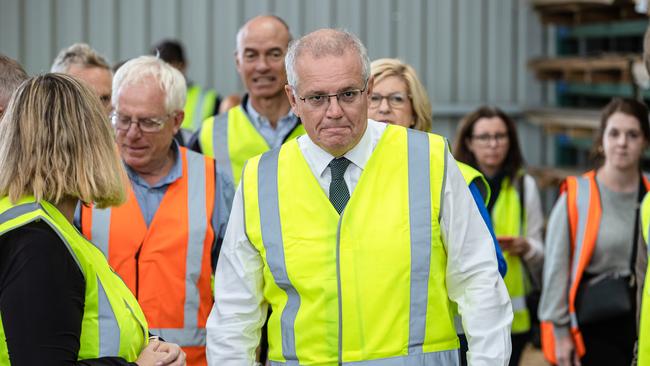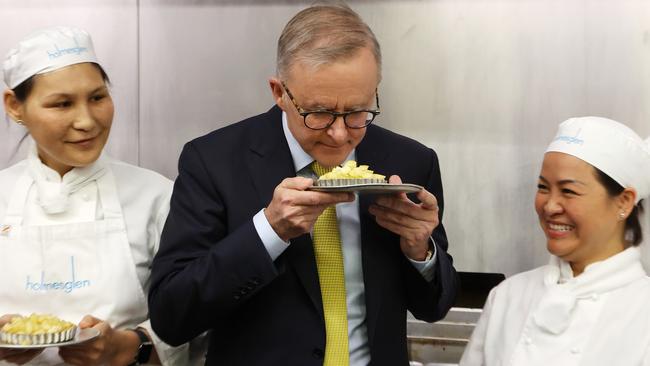Samantha Maiden: Prime Minister’s crack at ALP housing scheme reveals he is getting desperate
The Coalition’s vote is low. Enter the Prime Minister and his Bunnings-based conspiracy theory, writes Samantha Maiden.
Opinion
Don't miss out on the headlines from Opinion. Followed categories will be added to My News.
It was the moment Scott Morrison raised the chilling prospect of faceless bureaucrats peering into your trolley at Bunnings.
His target was Labor’s Help to Buy Scheme to help low and middle income earners to purchase a home, the centrepiece of Labor leader Anthony Albanese’s campaign launch.
As interest rates were hiked this week for the first time in more than a decade, the Labor leader has outlined a new housing affordability idea.
Labor’s pledge is to offer 10,000 low income workers the chance to buy a house with the government covering up to 40 per cent of their mortgage.
Where it gets complicated, according to the Prime Minister, is if you renovated the home.
How would you work out how much you put in before it was sold? Could the government claim 40 per cent of your improvements without covering the costs?
“Every time you go to Bunnings and you want to do an improvement on your house, you’ve got to check with Canberra because they share in the capital appreciation of their house. They take a cut,’’ the Prime Minister said.

In fact, what would occur is the same thing that happens in similar schemes that operate in South Australia and Western Australia.
A special valuation would occur if major renovations had been conducted but only when the house is sold. Nobody is going through your Bunnings receipts.
It was a ridiculous overreach that underlined what is now clearly on display: the Prime Minister is getting desperate.
While it’s true Labor’s primary vote remains low, delivering a degree of uncertainty and volatility, ALP strategists are increasingly confident they can form a majority government.
The Coalition’s primary vote is also low. But it cannot rely on a huge chunk of preferences from the Greens and Independents the way the ALP can.
Enter the Prime Minister and his Bunnings-based conspiracy theory.
The suggestion that you would need to report how much you spend at Bunnings was risible. The Prime Minister knows that isn’t true.
And it was even more risible because there are genuine questions about the details of how Labor’s scheme will operate.
For example, what happens if your wages go up? Under the scheme you are only eligible if you are earning less than $90,000 if you are single or under $120,000 in household income.
“If your wage goes above, your household income goes above $120,000 a year, Anthony Albanese will put a ‘for sale’ sign on your lawn,’’ Mr Morrison said.
“You actually have to dispose of the asset and pay back the government. I mean, this is insane.
It certainly could cause problems. However, it could also help some people enter the housing market who otherwise would not be able to do so.

“I mean, this is a scheme, which is designed for people on low and modest incomes, who really face a lifetime of rental right now, which gives them a genuine option of owning their own home,’’ Labor’s Deputy Leader Richard Marles said.
“Now, if during the course of their life, they acquire wealth, which means they themselves no longer qualify for the scheme, then in that circumstance, they would need to be buying out the government. And that’s fair.”
Then there’s the question of families having to sell the home to settle debts when a loved one dies.
But this is also the case for the Morrison Government’s own pensions loans scheme. That’s not a shared equity scheme.
It’s a reverse mortgage scheme allowing pensioners to secure a line of credit from their house to boost payments.
When you die, however, the bank also requires the estate to settle the debts.
Shared equity schemes are nothing new. Indeed a shared equity scheme already operates in South Australia.
More than 200 government-backed loans covering upfront property costs in South Australia have been approved for the 2022 financial year so far, and unsurprisingly demand is outstripping supply.
Under the scheme, with the state-owned lender HomeStart Finance, the Starter Loan provides interest-free and repayment-free loans of up to $10,000 for five years to borrowers, to cover the upfront costs associated with buying or building a home, such as stamp duty, fees, and charges.
Labor’s scheme is an entirely different quantum.
And that’s one glaring issue with the scheme that Labor has been keen to keep on the quiet.
When the Labor leader announced the plan at his campaign launch in Perth over the weekend, he claimed the scheme would “cost” $329m.
But that’s just the interest and admin costs. It’s left out the details on how much it will need to borrow.
What the Parliamentary Budget Office costings reveal – costs that remain unreleased by the Labor Party – is that it would involve taxpayers borrowing $7.3bn over the next four years.
It’s an important point and not one that the Labor leader has been put under any sustained pressure over to date on the campaign trail.
Overall, it’s worth a shot. If there’s only 10,000 places it won’t push up prices. But it does expose taxpayers to potential risks in the housing market.
As always, the devil is in the detail



